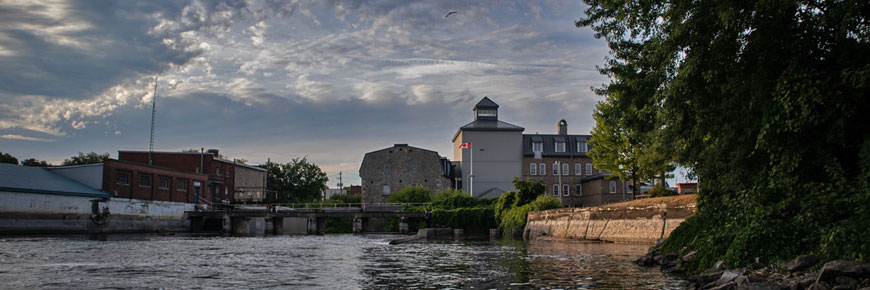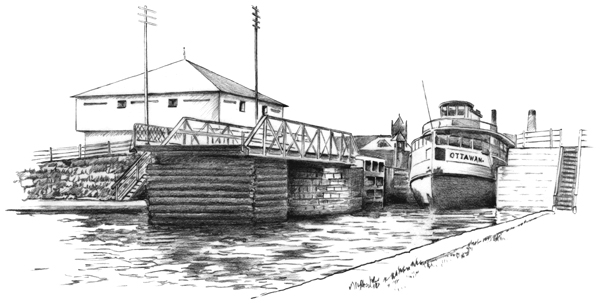
Culture and history
Rideau Canal National Historic Site
History of the Rideau Canal locks
Discover the history behind the 22 lockstations that make up the 202 km route from Ottawa to Kingston.
Merrickville Blockhouse National Historic Site
Merrickville Blockhouse is a two-storey, masonry and timber defensive structure located on the banks of the Rideau Canal in the town of Merrickville.
World Heritage
The Rideau Canal is one of Canada’s 20 World Heritage Sites, and one of two in Ontario.
Canadian Heritage River
The 202 km Rideau Waterway was designated in 2000 for its outstanding cultural and recreational heritage values.
The Rideau Canal was specifically designed for steam-powered vessels and is one of the greatest engineering feats of the 19th century. It is the best-preserved slackwater canal system and its mode of operation has changed very little since the beginning. The United Nations Educational Scientific and Cultural Organization (UNESCO) designated the canal a World Heritage Site in 2007.
Three eras
In the history of the canal there have been three different eras. The military period began with canal construction that provided a secure defensible supply route from Montreal to Kingston, an alternative to the St. Lawrence River in the uneasy years following the War of 1812. The Merrickville blockhouse is the largest military fortification that was built on the canal.
A slow military decline over the next couple of decades resulted in the canal becoming primarily a commercial waterway. Timber, potash, mica, feldspar, iron ore and phosphate were shipped along the Rideau by steamer and barge destined for the United States, Montreal or England. With the advent of railroads, which were quicker and more economical, the canal’s commercial activity became mostly local.
The 1880s heralded in the recreational period with luxury excursion steamers, such as the Rideau King and Rideau Queen, ferrying loads of travelers and sightseers along the picturesque waterway.
Today, the canal continues to be an international recreational attraction, accessible both by water and by land.
![Colonel By Watching the Building of the Rideau Canal 1826, (Ontario), [ca. 1930-1931]](https://pcweb2.azureedge.net/-/media/lhn-nhs/on/rideau/LAC_C-073703_cwjeffeys.jpg)
By C. W. Jeffreys [ca. 1930-1931] © Library and Archives Canada (LAC C-073703)
Background
Designations
The Need for a safe route to Upper Canada
The American Revolution created a hostile country to the south of Great Britain's Canadian colonies. For many decades after the establishment of the United States, Americans believed that the conquest of Canada was a piece of unfinished business left over from the revolutionary war. In the event of war the colony of Upper Canada (present-day Ontario) was at particular risk along the St. Lawrence River from Montreal to Kingston. The river route, vital for the transportation of goods and people to and from the Great Lakes area, was easily cut off because much of the southern shore of the river was in American possession.
The need to deal with the weakness of this water link to the Great Lakes became apparent when tensions between Great Britain and the United States led to war in 1812. Canada was fortunate to emerge unscathed after the two year war, but there was a clear recognition that something had to be done to resolve the issue of the vulnerable St. Lawrence River route.
Planning the Rideau Canal system
Following the War of 1812 surveys were carried out to identify a second, safe, route from Montreal to the Great Lakes. The decision was to follow the Ottawa River from Montreal to the mouth of the Rideau River, at present day Ottawa, then travel south along the Rideau and through a series of small lakes to the Cataraqui River which emptied into Lake Ontario at Kingston. Unfortunately, the route selected was navigable only in parts and to use it for boats larger than a canoe necessitated the construction of a series of locks between Ottawa to Kingston. Given the expense of such an undertaking, the project met with little enthusiasm with the British authorities, especially since relations with the United States had returned to normal after the war.

By arrived in Canada in 1826 and set up his headquarters near the mouth of the Rideau River. This was the origin of the settlement that was known for many years as Bytown and that eventually was renamed Ottawa. The overall design involved a series of dams and associated locks which would enable boats to travel without impediment from Bytown to Kingston. The original plan for the canal called for the construction of locks that could handle small barges. With considerable foresight, Colonel By boldly advocated a system of much larger locks. He finally persuaded his superiors to authorize the construction of locks with a minimum size of 134 feet long and 33 feet wide, large enough to accommodate the new steamboats which were beginning to appear on the Great Lakes.
The work and the workers
Work actually began on taming the rivers in 1827. Colonel By and a small contingent of Royal Engineer officers designed the Rideau Canal and supervised the project. The actual construction work was contracted out to private individuals. Most of the locks and dams were built of stone quarried on site, while the necessary iron fixtures were forged by local blacksmiths.The labourers who dug the lock pits, hauled the stones, and built the dams and locks were drawn from two main sources. Many came from the only major populated area in the country, the French-Canadian settlements of Lower Canada. Still others were recruited from the boatloads of immigrants - mostly from Ireland - who were beginning to arrive in Canada in ever-increasing numbers. Tragically, new recruits were always needed to replace workers who died from malaria, contracted in the many swamps along the route.
Achievement and disappointment
The Rideau Canal was officially opened in the summer of 1832. It was an amazing achievement. For most of its length of 202 km, the new canal passed through an unsettled wilderness where By and his workers managed to create forty-seven locks, some of them posing a considerable engineering challenge. Because of its military role, the canal also included defences in the form of fortified lock masters' houses and substantial blockhouses at the lock stations most exposed to possible enemy attack.Measured against what was accomplished, the financial cost was low: £ 800, 000. But far from applauding the achievement, the British Parliament of 1832 expressed its shock at the expenditure of such a sum of money and recalled By to face a parliamentary inquiry into his activities. While intensive investigation absolved Colonel By of any kind of mismanagement, he never received the honours his achievement should have earned him. He retired to private life, and died a disappointed man in 1836.

The rise and fall of the Canal
Although it was constructed as an alternative to the St. Lawrence River in case of war, the new Rideau Canal was more easily navigable than the St. Lawrence River with its series of dangerous rapids between Montreal and Kingston. As a result, after its opening in 1832, it became a busy commercial artery from Montreal to the Great Lakes. But its glory days were short-lived. By 1849, the rapids of the St. Lawrence had been tamed by a series of locks and commercial shippers were quick to switch to this more direct route.The Rideau Canal's heyday as a busy national highway ended in the 1850s, but the region it passed through remained ill-served by roads and railways until after the First World War, and so the Rideau continued to be an important local transportation system. It was even enlarged during this period, when the Tay Canal was completed in 1887 to connect the town of Perth with the main Rideau system.
After the First World War commercial traffic disappeared almost entirely from the Rideau. It was no longer of any value for military, commercial or transportation purposes. All that saved the system from abandonment was the high cost of taking it apart.
New life for the Rideau
Even before the decline of local commercial traffic, a new role for the Rideau Canal had begun to emerge. The natural beauty of much of the area through which the canal passes, along with the promise of excellent sports fishing, hunting and recreational boating stimulated the development of the tourism industry in the area and, by the end of the 19th century, hotels and private cottages made their appearance along the canal. The years since then have seen a massive expansion of the recreational use of the Rideau. Further, in more recent times, the historical value of the canal has become recognized. Declared by the Historic Sites and Monuments Board of Canada to be of national historic significance, the canal attracts thousands of visitors every year, anxious to learn about this remarkable engineering achievement and its role in the development of Canada.The largest and the most impressive of the four blockhouses built along the Rideau Canal for its defense and the second largest blockhouse surviving in Canada.
Merrickville Blockhouse National Historic Site
- Date modified :